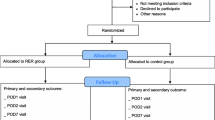Abstract.
Postoperative survivors' and nonsurvivors' hemodynamic and oxygen transport patterns have been extensively studied, and the early postoperative circulatory events leading to organ failures and death have been documented. Outcome was improved when potentially lethal circulatory patterns were treated during the early (the first 8–12 hours) postoperative period; but after the appearance of organ failure, reversal of nonsurvival patterns did not improve the outcome. The purpose of this study was to describe prospectively intraoperative circulatory deficiencies that precede shock, organ failures, and death. The ultimate aim was to elucidate nonsurvivor patterns at the earliest possible time to develop more effective preventive strategies for lethal organ failures. This approach is based on the assumption that it is easier and more effective to prevent the initiators of shock, such as hypovolemia, hypoxemia, poor tissue perfusion, and tissue hypoxia, than to treat the mediators of organ failure, such as cytokines, antigens, eicosinoids, and heat shock proteins. We monitored 356 high risk elective surgical patients with preoperative and intraoperative hemodynamic monitoring by the pulmonary artery (PA) thermodilution catheter. The conventionally monitored mean arterial pressure and heart rate remained in the normal range in both groups; the nonsurvivor pattern included decreased cardiac index, stroke index, stroke work, oxygen delivery, and oxygen consumption. Low oxygen consumption was partly compensated by increased oxygen extraction rates, and arterial pressures were maintained by increasing systemic vascular resistance. The early temporal pattern of nonsurvivors' changes were similar to those described during the postoperative period that preceded development of organ failure and death. This suggests that lethal circulatory dysfunctions may begin during the intraoperative period but become more apparent before and after organs fail during later postoperative stages.
Similar content being viewed by others
Author information
Authors and Affiliations
Rights and permissions
About this article
Cite this article
Shoemaker, W., Wo, C., Thangathurai, D. et al. Hemodynamic Patterns of Survivors and Nonsurvivors during High Risk Elective Surgical Operations. World J. Surg. 23, 1264–1271 (1999). https://doi.org/10.1007/s002689900660
Published:
Issue Date:
DOI: https://doi.org/10.1007/s002689900660




